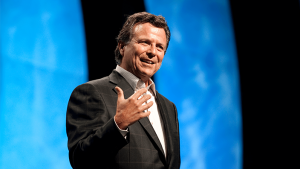According to Cliff Illig, Cerner was founded at a Loose Park picnic table on a bright summer day in 1979. Three friends and co-workers – Neal Patterson, Paul Gorup, and Illig – were working for the Arthur Andersen consultancy group and often met at their improvised outdoor office to write out a business plan for a software company.
"We made a list of businesses we knew a lot about: manufacturing, distribution, public utilities, and transportation," Illig recalled in a 2016 BizJournals interview. “Then we made a second list of industries we knew nothing about… and frankly, healthcare was on the second list."
The three entrepreneurs struck out on their own that fall to launch an IT consulting firm. In 1980, a client asked them to become involved in a health care initiative, and they discovered their passion for the medical industry. They spent the next several years building Cerner into a multi-billion-dollar health-tech company best known for its EHR solutions.
The only constant in business, however, is change and that fact finally caught up with Cerner after the sudden passing of co-founder and longtime CEO Neil Patterson in 2017. A prudent leader, Patterson left his Kansas City-based business with a succession plan, and Brent Shafer was named CEO six months later. Shafer is a well-seasoned leader who served in several senior positions with Philips North America before joining Cerner.
Quick to action, Shafer sought out ways to streamline operations: “Since assuming the role of chief executive officer…. I, along with our entire board and leadership team, have been reviewing Cerner’s operational and financial performance to identify opportunities to unlock the company’s significant potential,” Shafer said in a prepared statement.
“We are focused on effectively implementing a refined operating model to improve efficiency and profitability, while also innovating at scale for our clients and preparing Cerner for its next phase of growth and shareholder value creation,” he added.
After twenty years with Cerner, president Zane Burke was the first to step down following Shafer’s arrival as CEO. In November 2018, the position was eliminated to make way for the creation of a chief client officer role – intended to reflect the health IT company’s commitment as a client-focused organization.
Two months later, co-founder Cliff Illig announced that he would be leaving Cerner after spending close to 40 years building it with Patterson. “It was one year ago that we announced Brent (Shafer) as our new chairman and CEO,” Illig said in a release. “It’s very clear to me that the work that Brent and Cerner’s strong leadership team have done this past year has the company on the right path.”
Illig pointed to a growing number of outside interests that led him to step away from the company, and a SEC filing made at the time emphasized that his departure was not due to any disagreement with Cerner on "any matter relating to its operations, policies, or practices."
As Cerner was adapting to its post-Patterson existence, hedge fund firm Starboard Value saw a window of opportunity to drive change in what had once been a deeply-entrenched organization. With its well-earned reputation as an activist investor and, very likely, a careful courtship of Cerner’s other major shareholders, the firm pushed Cerner to sign an agreement outlining several changes. These included a board refreshment plan; operational improvement initiatives; commitments for operating margin targets; creation of a new Finance and Strategy Committee; and an expanded capital return program.
Following its Starboard contract, four new members were added to Cerner’s board of directors: John Greish, former president & CEO of Hill-Rom Holdings; R. Halsey Wise, former chairman and CEO of MedAssets; Melinda Mount, former president of AliphCom Inc.; and George Riedel, former chairman and CEO of Cloudmark. Two of these board members were chosen directly by Starboard. Also, Denis Cortese retired from his position on board after his term concluded.
Further changes to Cerner’s C-suite include Julie Wilson’s retirement from her role as chief people officer in June and the onboarding of once-Medtronic employee Tracy Platt who now serves as EVP and chief human resources officer. In September, Jeff Townsend announced that he would be stepping down as EVP and chief of innovation by the end of 2019.
Cerner shared that Darrell Johnson filled the newly-created chief marketing officer role while a November SEC filing revealed that Michael Nill, the current COO, would be moving on from his position in January 2020. Chief strategy officer Joanne Burns also announced she would be leaving at the same time.
Cerner’s new leadership has meant significant changes for the company, and investors are still waiting to see if management can deliver on some of their long term promises. Execution is what is expected from Shafer, but deteriorating margins and disappointing quarterly reports have left some analysts wondering about the future.
As for Illig, he believes that the company that he, Patterson, and Gorup planned out at that picnic table four decades ago will endure: “One of Neal’s enduring ambitions for Cerner was to build a visionary company, not just a company with a visionary,” he said. “He has done that. We have what I believe is the best management in health IT, and we have associates who think as much about the future as they do the present. As a result, Cerner is well-positioned to have a pioneering impact on the provision of health care in the years to come.”























